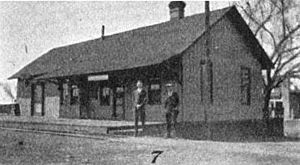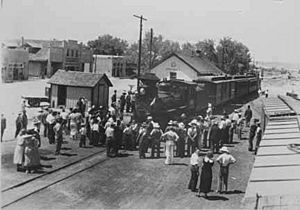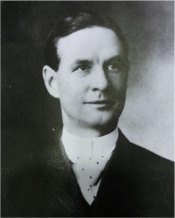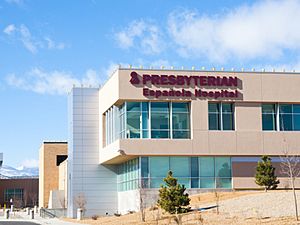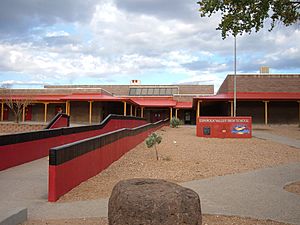Española, New Mexico facts for kids
Quick facts for kids
Española
|
||
|---|---|---|
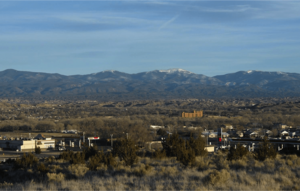
Skyline view from the city's Industrial Park
|
||
|
||
| Etymology: Founded as San Juan de los Caballeros, as capital of Nuevo México for Española (Spanish) | ||
| Nickname(s):
"The Low Rider Capital of The World", Spaña, Espa
|
||
| Motto(s):
The heart of northern New Mexico…where cultures unite.
|
||
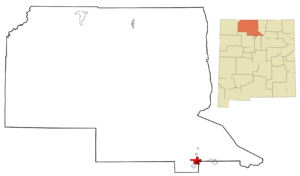
Location of Española, New Mexico
|
||
| Country | United States | |
| State | New Mexico | |
| County | Rio Arriba, Santa Fe | |
| Founded | 1598 | |
| Incorporated | 1925 | |
| Named for | See history section | |
| Government | ||
| • Type | Mayor-council government | |
| Area | ||
| • Total | 8.34 sq mi (21.61 km2) | |
| • Land | 8.22 sq mi (21.30 km2) | |
| • Water | 0.12 sq mi (0.31 km2) | |
| Elevation | 5,591 ft (1,704 m) | |
| Population
(2020)
|
||
| • Total | 10,526 | |
| • Density | 1,280.22/sq mi (494.29/km2) | |
| ZIP codes |
87532, 87533
|
|
| Area code(s) | 505 | |
| FIPS code | 35-25170 | |
| GNIS feature ID | 2410456 | |
Española is a city mostly in Rio Arriba County, New Mexico, United States. A small part of the city is also in Santa Fe County. Española started as a railroad town. It was built near an older Native American town called San Juan de los Caballeros. The city was officially made a city in 1925. Some people call it the first capital city in the United States. In 2020, about 10,526 people lived there. Española is part of a larger area that includes Albuquerque, Santa Fe, and Los Alamos.
Contents
History of Española
What Does the Name Española Mean?
Before railroads arrived, Española was known as La Vega de los Vigiles. This means 'the Vigils' Meadow'. The name La Española means 'Spanish woman'. Some stories say railroad workers named the area after a woman who ran a small restaurant. But the name is actually a shorter version of Plaza Española, which means 'Spanish town'. This name probably helped tell it apart from the nearby Tewa pueblo.
Early Spanish Settlement
Tewa people have lived in this area since the 1200s. They built towns called 'pueblos'. Four of these pueblos are still here today: Ohkay Owingeh, Pojoaque, Santa Clara, and San Ildefonso.
Spanish explorers first came to the Rio Grande region in 1540. Don Juan de Oñate brought the first Spanish settlers here in 1598. His group stayed at Ohkay Owingeh for a while. They called this Tewa town San Juan de los Caballeros. Later, they moved to an empty Tewa village and renamed it San Gabriel. San Gabriel was close to where Española is now. It is considered the first capital city founded by Europeans in what is now the United States.
Oñate arrived in the Española area on July 11, 1598. He set up a camp where the Chama River meets the Rio Grande. This place was then called Yunque-Yunque. About 100 years later, Don Diego de Vargas built his town at Santa Cruz, near the same area.
The Railroad Era in Española
Before the Denver and Rio Grande Railroad arrived in 1880, the small town on the west side of the Rio Grande was called La Vega de los Vigiles. This name came from the Vigil family, who first settled there. Records show people lived in La Vega de los Vigiles by 1751. When the railroad came, the town's name changed to Española.
Española was the end of the railroad line until 1886. The railroad built a place to fix train engines, including a roundhouse and a turntable. These facilities were taken down after only six years because plans for the town changed. This railroad line was later known as the "Chili Line". It was meant to connect Denver with Mexico City, but this plan did not succeed.
The railroad sold land in the downtown Española area. Business people and settlers from other places slowly moved into Española. Frank Bond and his brother George, who were from Canada, came to the city. They built the largest store in New Mexico and a very successful wool business. Their businesses brought a lot of economic growth to Española. Española became the main office for all of the Bond family's businesses, which included over 12 companies across New Mexico.
Frank R. Frankenburger was the first elected mayor in 1923. However, the first mayor chosen for his popularity was Frank Bond in 1907. In 1925, Española officially became a city. As more people moved in, there was a need for public schools. Española High School was built and was the largest school in the area for many years. The very first high school in the area was Santa Cruz High School. It opened in 1906 in the historic Santa Cruz area, two miles from downtown Española. Today, neither of these high schools are open. They merged with other schools in 1975.
The railroad became less important over time. Not many passengers rode the trains, and fewer goods were shipped. The railroad closed in 1941, and the tracks were removed the next year. Many local people lost their jobs. They followed the railroad to other cities like Santa Fe, Albuquerque, and central Colorado to find work. Española's population dropped a lot, and many homes in downtown became empty. Most people who stayed turned to farming. Many thought Española would become another failed railroad town. The city removed the old railroad tracks and the train station in the 1960s.
Española After the Railroad
When the Manhattan Project started in nearby Los Alamos, many people from Española found jobs at the Los Alamos National Laboratory (LANL). Almost 9% of Española's residents have worked at LANL.
In the 1980s, many old and important buildings were torn down. This was part of a plan to make the city look new, called urban renewal. Española was not the only New Mexico city to do this, but in Española, it did not work well. More modern businesses started to move in. However, the growth of Española spread east across the Rio Grande. Some historic buildings still stand in downtown Española, but many are empty or not used.
In the 1990s, there was a plan to build a "plaza" and a mission church. This was a bit controversial because many historic buildings had to be removed. The city and locals supported the idea. Española never had a plaza before the railroads. It was built to honor the Spanish culture in the area.
Recent Events in Española
On September 18, 2008, Barack Obama visited Española. He was running for president at the time. He held a rally at the city's New Plaza in the Main Street area.
Geography of Española
Española covers about 8.34 square miles (21.61 square kilometers). Most of this area is land, with a small amount of water.
The city is about 5,595 feet (1,705 meters) above sea level. It sits in a valley between the Jemez and Sangre de Cristo mountain ranges. Three rivers meet near Española: the Rio Grande, the Rio Chama, and the Rio Santa Cruz.
Climate and Weather
Española has a cool, dry climate. It is hotter and drier than nearby cities because it is at a lower elevation.
July is the hottest month, with an average high temperature of 91°F (33°C). The highest temperature ever recorded was 107°F (42°C) in 2003. January is the coolest month, with an average high of 45°F (7°C). The lowest temperature ever recorded was -38°F (-39°C) in 1971. Most rain falls in August, with an average of 1.90 inches (48 mm).
| Climate data for Española, New Mexico | |||||||||||||
|---|---|---|---|---|---|---|---|---|---|---|---|---|---|
| Month | Jan | Feb | Mar | Apr | May | Jun | Jul | Aug | Sep | Oct | Nov | Dec | Year |
| Record high °F (°C) | 67 (19) |
75 (24) |
84 (29) |
88 (31) |
98 (37) |
105 (41) |
107 (42) |
103 (39) |
99 (37) |
89 (32) |
84 (29) |
72 (22) |
107 (42) |
| Mean daily maximum °F (°C) | 45 (7) |
52 (11) |
60 (16) |
69 (21) |
78 (26) |
88 (31) |
91 (33) |
87 (31) |
81 (27) |
72 (22) |
58 (14) |
47 (8) |
69 (21) |
| Mean daily minimum °F (°C) | 14 (−10) |
20 (−7) |
26 (−3) |
33 (1) |
41 (5) |
50 (10) |
57 (14) |
55 (13) |
47 (8) |
34 (1) |
24 (−4) |
15 (−9) |
35 (2) |
| Record low °F (°C) | −38 (−39) |
−18 (−28) |
0 (−18) |
14 (−10) |
17 (−8) |
28 (−2) |
35 (2) |
37 (3) |
25 (−4) |
10 (−12) |
−21 (−29) |
−16 (−27) |
−38 (−39) |
| Average precipitation inches (mm) | 0.40 (10) |
0.40 (10) |
0.60 (15) |
0.60 (15) |
0.70 (18) |
0.70 (18) |
1.60 (41) |
1.90 (48) |
1.20 (30) |
0.90 (23) |
0.60 (15) |
0.50 (13) |
10.1 (256) |
| Source: weather.com | |||||||||||||
Clean Air Quality
In 2011, a report by the American Lung Association said that the Santa Fe–Española area had some of the cleanest air in the country. It was ranked #1 for the cleanest ozone layer. It was also #1 for clean air regarding 24-hour particle pollution and #2 for annual particle pollution.
Population and People
| Historical population | |||
|---|---|---|---|
| Census | Pop. | %± | |
| 1890 | 398 | — | |
| 1900 | 1,405 | 253.0% | |
| 1910 | 1,802 | 28.3% | |
| 1920 | 2,412 | 33.9% | |
| 1930 | 4,269 | 77.0% | |
| 1940 | 2,984 | −30.1% | |
| 1950 | 2,489 | −16.6% | |
| 1960 | 3,472 | 39.5% | |
| 1970 | 7,923 | 128.2% | |
| 1980 | 8,127 | 2.6% | |
| 1990 | 8,828 | 8.6% | |
| 2000 | 9,504 | 7.7% | |
| 2010 | 10,495 | 10.4% | |
| 2020 | 10,526 | 0.3% | |
| U.S. Decennial Census | |||
In 2010, there were 10,224 people living in Española. The city's population is very diverse. About 87.1% of the people were Hispanic or Latino.
Economy and Jobs
| Largest Employers in Española | |
|---|---|
| 1 | Los Alamos National Laboratory |
| 2 | Española Public Schools |
| 3 | Presbyterian Healthcare Services |
| 4 | Akal Security |
| 5 | Northern New Mexico College |
| 6 | Northern Pueblos Gaming Council |
| 7 | Walmart |
| 8 | Lowe's |
| 9 | City of Española |
| 10 | Rio Arriba County |
The Los Alamos National Laboratory is the biggest employer in Española. Over 12% of the people who live in Española work there. The education sector is the second largest employer. The Española Public Schools is the 16th largest school district in New Mexico.
Recently, Northern New Mexico College has grown a lot. It has added more degree programs and improved its campus. They built a new library and a new School of Education. Other large local businesses include Akal Securities Inc., a security company that employs over 500 people.
Española has also seen a lot of new stores and restaurants. Many of these are on Riverside Drive, which is a major road in the city. A large shopping center opened in 1999, and other stores followed.
Plaza de Española
The fountain at Plaza de Española looks like the famous Alhambra in Spain. The plaza is also home to the Convent Mission. This mission is managed by the Episcopal Church.
Telecommunications
Satview Broadband used to be the local cable television company. However, due to a legal issue, they stopped services in Española in March 2016. Now, the city uses different satellite TV services. Windstream Communications provides phone and internet services.
Festivals and Fun Activities
Española's restaurants and stores are popular with people traveling between Santa Fe and northern towns. They are also popular with local residents. The local fiestas are held in the summer. They celebrate the Spanish settlement and the start of Christian faith in the area. These fiestas include live New Mexico and country music. There are also vendors and parades.
Many places near Española offer outdoor activities. You can go hiking, biking, and enjoy river sports like rafting and kayaking. In the winter, you can go skiing and snowboarding.
Parks and Recreation
Recreational Facilities
- Penny Roybal Garcia (Ranchitos) Aquatic Center
- Richard L. Lucero Recreation Center
Major Community Parks
- Plaza de Española Park
- Vietnam Veteran's Memorial Park
- Ranchitos Park
- Valdez Park (named after Española native Phil Valdez)
Education in Española
Public Schools
The City of Española is part of the Española Public Schools district. Six of its 14 schools are located within the city.
- Secondary schools
- Española Valley High School
- Carlos F. Vigil Middle School
- Elementary schools
- Eutimio Tim Salazar III "Fairview" Elementary
- James H. Rodriguez "Española" Elementary
- Tony E. Quintana "Sombrillo" Elementary
- Kindergartens
- Los Niños Kindergarten Center
Charter and Tribal Schools
- McCurdy Charter School K-12
- La Tierra Montesori School of the Arts and Sciences
- Carinos de los Ninos Charter School
There is also a tribal elementary school called Kha'p'o Community School. It is linked with the Bureau of Indian Education (BIE). While it has an Española address, the school is actually in Santa Clara Pueblo.
Private Schools
- Holy Cross Catholic School (Roman Catholic Archdiocese of Santa Fe)
- Victory Faith Christian Academy
College
- Northern New Mexico College
Public Library
The Española Public Library is located inside the Richard Lucero Center. It has about 50,000 items in its collection.
Notable People from Española
- Jack Aeby, environmental physicist
- Eppie Archuleta, weaver and textile artist
- Frank Bond, Canadian businessman
- Jacobo de la Serna, ceramic artist
- Kenneth John Gonzales, attorney and judge
- Robert B. Hall, geographer
- Leo Jaramillo, member of the New Mexico Senate
- Joseph Maestas, member of the New Mexico Public Regulation Commission
- Joe Mondragon, jazz musician
- Hari Jiwan Singh Khalsa, Sikh leader
- Patricia D. Lopez, computer scientist
- Richard Lucero, longest-serving mayor of Española
- Roger Montoya, humanitarian, artist, former gymnast, and politician
- Members of The Movin' Morfomen
- Nora Naranjo Morse, artist and poet
- Satya Rhodes-Conway, politician in Madison, Wisconsin
- Raemer Schreiber, physicist
- Harbhajan Singh Khalsa, founder of the 3HO movement, moved to Española
- Debbie Rodella, New Mexico state legislator, was born in Española.
- Scott Tipton, Member of the U.S. House of Representatives from Colorado's 3rd district, was born in Española.
See also
 In Spanish: Española (Nuevo México) para niños
In Spanish: Española (Nuevo México) para niños




